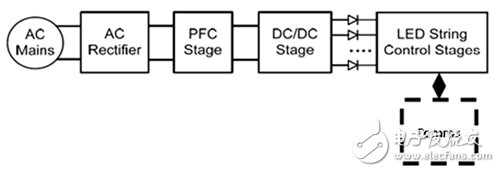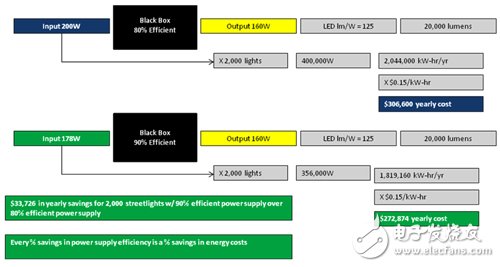Adding smart functionality to a light-emitting diode (LED) lighting application requires changing the fixed-function LED driver to a microcontroller (MCU) or Programmable Architecture. For applications that require advanced features, MCUs can be used to achieve many intelligent functions, such as NaTIve Dimming Control, Specialized Color Mixing, Adaptive Lighting Control (AdapTIve LighTIng Control) and remote links. (Remote ConnecTIvity).
For lighting applications, MCUs dedicated to Power Electronics products can even effectively control the power supply of the fixtures, making them cost-effective and enabling lighting control and communication. As with the trend of many modern electronic products, the use of digital control has opened up more flexible space and brought new levels of intelligent functions and differences to lighting products.
Dedicated MCUs meet the LED application market
The lighting industry has undergone rapid evolution, and today's LED technology shows many benefits. However, different types of LED lighting applications vary greatly depending on the features supported. Among them, residential applications include bulb replacement, Accent Lighting and small-scale outdoor lighting. Generally speaking, only one or two LED strings need to be lit, but this market has cost pressure, so the advanced control is still Not universal. For commercial applications, including Fluorescent Ballast, bulb replacement and accent lighting, only one or two LED strings need to be lit, which is also subject to cost considerations. This market is highly energy-conscious; High-end applications require remote connectivity and intelligent controller functionality.
In addition, for entertainment applications, high-end displays and mood lighting (Mood Lighting) are included. Complete intensity control and consistent color quality are important. For industry-standard communication protocols such as Digital Addressing Lighting Interface (DALI) or DMX-512, remote connectivity and support are also important. Outdoor and infrastructure construction includes street lighting, factory and office building lighting. The equipment in this market generally has a large number of LEDs and must support many light strings. Among them, high-brightness LEDs are also quite common, and these applications are quite Remote connection and height intelligent controller are required.
Reduce system construction cost MCU to achieve high elasticity LED lighting
The simplest LED lighting system uses LED drivers. These fixed-function devices provide direct control of the LEDs at a relatively low cost. In general, these devices achieve good energy efficiency and do not require software programming. In the worst case, the developer has to do multiple calculations to select the desired drive or to determine the configuration values ​​of the board components.
Although LED drivers can be used directly, they are less flexible for more advanced systems. To support different types of LEDs (such as high wattage or different colors), or different LED string configurations, different solutions may be required. In fact, any changes to the system (such as the number of LEDs in the string and the number of strings) may cause the drive to change as well. As a result, most lighting products supplied by original equipment manufacturers (OEMs) may require unique analog drives. For large series of products, this will increase the number of inventory items for OEMs or suppliers, which may result in reduced economic size or increased equipment costs.
On the other hand, intelligent controllers allow developers to build more flexible lighting systems. In the MCU system, the code can be set to support various LEDs, unique power level requirements, different string lengths, and different numbers of strings without major hardware changes. The system can also be designed to automatically detect which LEDs need to be driven. The programmable features of the MCU system also enable advanced dimming and sequencing functions, providing more advanced lighting scene control and automated lighting brightness.
Flexible digital control allows OEMs to design a single controller that can control multiple products. Since the controller IP can be reused, it can also significantly reduce the design investment; the flexible controller can also reduce the number of devices in stock, while reducing the overall system cost through greater economies of scale.
Realizing intelligent LED lighting digital control integration is indispensable
The basic architecture of the intelligent LED lighting system consists of one main stage, namely Power Conversion, LED Control and Communication (Figure 1). The power conversion phase delivers the correct voltage and current to the LEDs. First, AC-DC rectification is performed, followed by a power factor correction (PFC) phase, and finally one or more parallel DC-DC conversion phases are performed. To provide efficient power conversion, these conversion stages must be controlled with precision and flexibility.

Figure 1 Intelligent LED lighting system includes power conversion, LED control and communication.
Intelligent controllers are required to maintain efficiency and functionality at all major stages. When using a fixed-function analogy, individual PFCs, DC-DCs, LEDs, and communication controllers may be required. However, when using a dedicated power electronics MCU, the component cost of the lamp power supply can be reduced through a high degree of integration. With ample power, power-optimized perimeters, and ample communication connectivity, a single MCU can control the potential of major components such as lighting system power levels, LED lighting control, and communications. Through the MCU's digital integration function, the lighting system can reduce many unnecessary components while using a central programmable platform to coordinate the control of the intelligent lighting system.
Digital power control also improves the conversion efficiency of dynamic systems. Although LEDs are more efficient than traditional lighting, operating and energy costs are relatively low, but not all LED systems are identical. When dimming, changing color output, or adjusting brightness output in any way, digital power control enables the power level of the LED lighting system to achieve higher efficiency. Also in the case of fixed lighting, the MCU is also able to improve operational performance through a more advanced power stage design. This efficiency gain is quite attractive to end users and is a significant difference for two LED systems that are otherwise identical.
For example, suppose a city plans to replace two thousand street lights, and the efficiency is 10% when comparing the two models (Figure 2). It is worth noting that the high efficiency system has a system input power of 178 watts (W), while the low efficiency system requires 200 watts to achieve the same 160 watts of illumination output. Equivalent to an annual energy cost savings of 10%, the energy efficiency calculation of the power supply is equivalent to saving 33,726 US dollars, which is much higher than the cost saved by the LED system.

Figure 2 The digital control of the power supply can achieve higher conversion efficiency than the analog system, and the cost savings are higher than LED technology. In this example, a 10% efficiency difference is equivalent to an annual energy cost savings of 10%, and the energy efficiency calculation for a power supply alone is equivalent to a savings of $33,726. Such efficiency is quite attractive to end users and is a key difference for two LED systems that are identical in all other parts.
PPS Expandable Braided Sleeve is a type of protective sleeve that is used to protect and organize cables, wires, and hoses. It is made from a high-quality polyester material that is braided in a tubular shape. The expandable design allows the sleeve to easily expand and contract, accommodating different sizes of cables and wires.
Pps Expandable Braided Sleeve,Pps Braided Sleeving,Pps Expandable Sleeve,Pps Braided Sleevings
Dongguan Liansi Electronics Co.,Ltd , https://www.liansisleeve.com